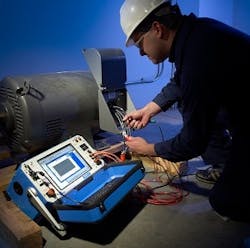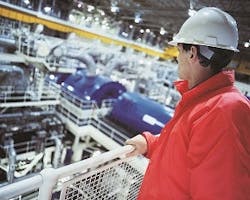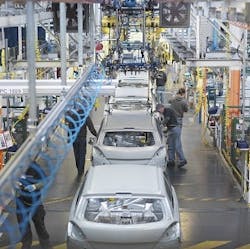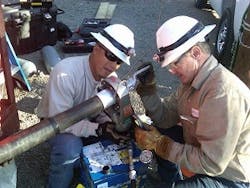Overcome potential problems with power quality
Power is a critical resource to an industrial plant, so power problems require power solutions. Many industrial facilities have their own on-site power-generation capabilities to reduce energy costs and to compensate for the potential of short-term utility outages. Power quality can have different kinds of impact on operations and production. There are just as many causes of poor power quality as there are options to solve them, and many of them are extremely affordable.
Harmonic distortion
"Voltage imbalance is a huge issue with motors," says Dan Chamberlain, electrical PDG lead CCMNA for Cargill in Dayton, Ohio. "Allied Reliability Group has been working with all of Cargill's corn milling facilities for a number of years and always helped us investigate the sources of this imbalance. For example, they would conduct on-line motor testing and look for total harmonic distortion, both from current and voltage. One solution was to install harmonic filters."
Harmonic distortion from poor power quality in industrial facilities can cause overheating, says Dave Sirmans, CMRP, electrical subject matter expert with Allied Reliability Group. "When variable frequency drives are applied, they are a non-linear load, and they distort the current sine wave of the incoming power that is reflected back to the service, such that transformers feeding that service will often overheat," he says. "Transformers are not equipped to deal with harmonic overheating." Negative sequence harmonics also cause electric motors to overheat. "Negative sequence harmonics will actually impose torque in an electric motor," says Sirmans.
One solution is to install isolation transformers on certain loads that have an impact, such as a group of motor loads that are run by variable frequency drives (VFDs), or non-linear loads in one part of the facility, says Sirmans. "A transformer that is rated for the kind of harmonics that you get can isolate those loads from the rest of the system," he says. "This usually takes care of the majority of problems."
Another solution is to make sure that you have the appropriate electrical system grounding. "You might have a plant that was designed to package food products 40 years ago but was sold and is now making Styrofoam cups," says Sirmans. "However, the electrical infrastructure might have remained unchanged the entire time." An electrical design from 40 years ago wasn't necessarily designed to handle the kind of distortion that you get from modern equipment, and a lot of facilities neglect testing the electrical integrity of their systems. "You need to test the grounds and make sure the whole system is electrically sound," he says.
Voltage transients
Figure 1. Insulation tests can be performed on electric motors to ensure they can withstand high voltage power transients.
(Source: SKF)
"It is important to monitor power quality," says Randy Keener, president of Torq Engineering. "It doesn't need to be done constantly but should be done periodically. During the monitoring, it is important to measure three things — voltage levels, voltage unbalance, and harmonics." If you have these problems, it can cause electrical equipment, especially motors, to run hot (Figure 1). "This shortens the life of the insulation, such that the equipment fails sooner than it otherwise would," he says.
While most professionals are aware of the importance of monitoring voltage levels, voltage unbalance, and harmonics, fewer pay as much attention to the problems associated with voltage transients, which are voltage spikes of very short duration that occur primarily internally but can also result from outside sources, such as lighting. Voltage transients can sometimes be two to five times higher than normal line voltage, explains Keener, and they can cause insulation systems to fail or at least be permanently degraded and fail very rapidly from there. "A lot of people don't even realize that transients exist, and they are not detected during normal power quality monitoring with typical lower-quality power meters," says Keener. "You need specialized equipment for this."
One solution to address voltage transients is to install low-voltage transient suppression devices. Another is to use motor soft starts to avoid instantaneous high changes in current that cause voltage transients. However, this won't eliminate the problem of transients when you stop the motor. One alternate solution, says Keener, is a variable speed device, which is useful in reducing voltage transients because it will soft-start and soft-stop motors. "Some of these variable speed devices generate a little bit of transients themselves, but not nearly as much as the motors themselves," he says.
Grounding systems
Figure 2. Many power disturbances result from degradation of, or damage to, power wiring systems in an industrial facility, especially to the grounding systems.
(Source: Schneider Electric)
At best, poor power quality equals higher production costs in an industrial facility, says Larry Ray, director of engineering for Schneider Electric Engineering Services. "Severe power quality issues can result in damage to sensitive equipment and even harm to workers," he says. In those cases, the costs are more than just lost productivity. Electronic devices associated with computers and communications networks contain sensitive components that can be affected by small variations in supply voltage, whether line-line, line-neutral, neutral-ground, or even ground-ground.
"Pay attention to the basics," says Ray. Recognize that many power disturbances result from degradation of, or damage to, power wiring systems in an industrial facility, especially to the grounding systems (Figure 2). "We normally don't think of an effective ground path as even necessary, much less half of the power circuit," he says. "However, that is the case during a ground fault. When an energized conductor comes in contact with parts of the industrial facility not intended to be energized, it is crucial that those metallic surfaces are well bonded to each other and are also equipped with an effective ground path that permits over-current protection devices to operate quickly." An effective grounding system ensures that employees are safe, that equipment damage is limited, and that the trouble is limited to the smallest part of the electrical system (Figure 3).
Figure 3. An effective grounding system ensures that employees are safe, that equipment damage is limited, and that the trouble is limited to the smallest part of the electrical system.
(Source: Schneider Electric)
Excluding power quality events associated with wiring and grounding, the next culprit is generally disturbances generated on the electric system, or due to misapplication of other loads within the facility. "This is where a power monitoring system can be an economical investment," says Ray. It is important to monitor voltage and current at key nodes within the facility, starting at the utility service entrances, and applying meters at various points in the system. Damaging power disturbances can last only a fraction of a second (transients) or many hours (single-phasing). "As such, the metering system needs to be able to trigger on high-speed events and be able to log voltage, current, power, power factor, and other parameters on a regular time interval," he says. "The power monitoring system should also be able to warn the user of out-of-tolerance parameters and even predict pending trouble spots before they occur."
Power quality surveys
The effects of power quality can be as severe as losing voltage to operate machinery, says Frank Healy, power quality product marketing manager for Fluke. The effects of loads (powered equipment) can cause the draw of circuit on a circuit to be of such a high value that it causes circuit breakers to operate. "This can be due to high current or due to the distortion caused by polluting loads," he says. In come cases, the distortion may be less severe, but harmonics may cause overheating of key components, such as transformers. Over time, the temperature rises can affect the lifetime of the equipment. "Another possible effect of poor power quality is dips and swells, where the voltage either goes below the required voltage limit or above," he says. "In either case, the operating equipment can fail, or at least be disrupted."
One final case to consider is when short duration changes in voltage (transients) occur, says Healy. These transients can be caused by equipment switching, or sometimes occur as the after-effects of lightning strikes. "These events often cause automated equipment to misoperate," he says. "The voltage changes can cause control signals to the equipment to be lost of misinterpreted."
What are some ways to avoid these problems? It is best to start with some knowledge of what the source of the power quality problem is, says Healy. This can be achieved by performing a power quality survey using a power quality measuring instrument. "By characterizing the incoming voltage and monitoring how the equipment in the facility causes the voltage to be affected, it is possible to mitigate the power quality issue," he says.
First, the user should determine what may be the most susceptible equipment in light of understanding the state of health of the voltage supply. Often, the most susceptible equipment is the computer or programmable logic controller (PLC) that is controlling the equipment, explains Healy. "By adequately protecting these devices, power quality problems can be avoided," he says. The protection for such equipment can be filters on the incoming voltage to ensure that only voltage of the desired magnitude and frequency is supplied. If voltage is being lost for some reason, then ride-through power will be required, which can be in the form of an uninterruptible power supply (UPS). "The UPS can back up the power for either very short periods of time, using energy stored in capacitors or inductors, or for longer periods of time using batteries," he says.
The power quality survey can enable the user to save a huge amount of money, as the investment in mitigation equipment can quickly increase if incorrect measures are made, explains Healy. "Target solutions will provide the most economical and effective results," he says.
Cost-effective solutions first
Poor power quality can be caused internally or externally, explains Bob Kirslis, industrial market manager for the electrical engineering services and systems division at Eaton.
Internal power quality problems are generated by one or more parts of the facility itself. "These can be the result of harmonic-generating equipment, which affects the voltage in the facility in many different ways," says Kirslis. "Also, starting large motors in the facility can cause voltage droops." One facility was performing welding on the landing gears for airplanes, which involved precision work on high-cost metal. "The harmonics that the plant was generating when starting motors were affecting the welders, because, as the voltage dropped, it changed the beads on the welds," says Kirslis. "This led to a lot of quality issues.”
Adding to these problems is that some manufacturers of electronic equipment factory-set the equipment such that there is a very small voltage bandwidth in which the equipment can operate. "As a result, voltage sags or surges can cause the voltage to end up outside the operating parameters of the equipment," says Kirslis. "As such, the equipment often can't operate because, with large motors being started and stopped, the voltage rarely stays within the designated parameters."
The solution is to either find a way to consistently bring the voltage back to within the tight parameters set by the equipment manufacturer or broaden the parameters of the equipment, says Kirslis. "The first step is to try to broaden the parameters in which the equipment can operate, instead of trying to bring the voltage to within the existing tight parameters," he says.
However, if it turns out that the equipment does need to operate within those existing tight parameters, then you need to work on the voltage. For example, a UPS or line filter may be a cost-effective solution — that is, protecting the equipment with a pure voltage source or filtering out the harmonics. Another option is to move the motors to a different transformer so that certain equipment isn't affected by the starts and stops.
An external cause of poor power quality is to another facility on the grid negatively affecting your power. "Of course, this is a more difficult one to address, because you have no control over what the utility gives you," says Kirslis. One plant had a very large harmonic load — so large, in fact, that the harmonics it was generating were affecting a wastewater treatment plant a mile down the road. "In situations like this, the source of the problem is outside the plant," explains Kirslis. Here, the wastewater treatment plant would need to protect its equipment from the whole incoming service, and this isn't always feasible. As such, the first step, and the most cost-effective one, would be to contact the utility and ask what they can do to solve the problem, suggests Kirslis. "If the utility can't or won't solve the problem, then you need to focus on the specific equipment needs and put the right solutions there," he says.
Damaged cablesMedium voltage cables can fail at any time if they are more than 20 years old, says Brinton. While some can last many years longer, they are more likely to fail early if they are in warmer climates or if they run with higher loads. "When a cable does fail, a major unit or the complete plant can be shut down until a replacement cable is installed," says Brinton. In some cases, it can take a week or more to locate the right cable, get it shipped, install it, and restart the units.
Medium voltage cables fail because of a process called "water treeing," in which molecular moisture from the atmosphere, soil, or standing water diffuses into the cable insulation. Over time, microvoids form, which reduce the effective amount of insulation too much, such that the cable faults and an outage occurs. "Within six weeks of being placed into service, a cable is probably saturated with the maximum amount of water that the insulation can hold, which might be 0.1%," says Brinton. "The water then forms water trees, which grow over time. They grow faster in warmer temperatures and when the cable is subjected to higher loads."
As a way to attempt to prevent unexpected cable failure, some industrial facilities opt for cable testing. However, the kinds of testing that are available today cannot predict when a cable is going to fail. "They can only identify trends," says Brinton. "In addition, some types of testing can actually damage the cable, thus shortening its life."
As such, when it comes to cable, the most common plan of action for industrial plants is to run to failure, which eventually leads to unplanned outages.
One way to reduce the chances of cable failure, besides the obvious option of replacing the old cable with new cable prior to a failure, is to utilize a process called rejuvenation. In this process, the cable is de-energized, the connectors on each end are removed, and rejuvenation fluid is pumped through the cable strands until it comes out the other end. "The fluid is then sealed inside the cable, new electrical termination kits are put on each end, and the cable is re-energized," says Brinton. The process usually takes two to four hours, and, in most cases, the process allows the cable to last another 40 years.”
When a cable failed on one phase of one set of four cable circuits in Terra Industries' nitrogen manufacturing plant in Woodward, Oklahoma, plant management was concerned that a similar failure on the second set of cable circuits could shut the plant down. Each cable is about 600 ft long and runs from the incoming power line pole, underneath a parking lot, and into the switchgear from a below-ground vault. The plant used cable rejuvenation. "We were very impressed with the process," says Melvin Boedecker, the plant's maintenance supervisor. "Novinium identified problems with our terminations that we had not recognized and then solved them. We also liked the fact that the injection did not leave any smell in our plant. All chemical mixing was done outside. When they came inside, everything was sealed." In addition, cable injection ended up being only one-tenth of the cost of replacing the existing cables, says Boedecker.
Companies create a cable risk profile, starting when cables are around 20 years old, recommends Brinton. This involves identifying the cables that pose the highest risk and then arranging for rejuvenation of those cables. Rejuvenation of the additional cables can take place over the next five to 10 years. "As a result, by the time the cables are 30 years old, they have all been rejuvenated," says Brinton.




